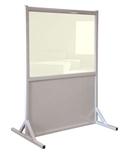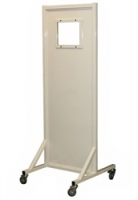Time, Distance, and Shielding
Time, distance, and shielding are the three basic concepts of radiation protection that apply to all types of ionizing radiation. Shielding simply means having something that will absorb radiation between the source of the radiation and the area to be protected. Radiation shielding is based on the principle of attenuation, which is the gradual loss in intensity of any energy through a medium.Lead acts as a barrier to reduce a ray’s effect by blocking or bouncing particles through a barrier material. When X-ray photons interact with matter, the quantity is reduced from the original x-ray beam. Attenuation is the result of interactions between x-ray and matter that include absorption and scatter. Differential absorption increases as kVp decreases. The greater the shielding around a radiation source, the smaller the exposure.
X-Ray And Gamma Rays
X-ray and gamma rays are forms of electromagnetic radiation that occur with higher energy levels than those displayed by ultraviolet or visible light. Thick, dense shielding, such as lead, is necessary to protect against the energy emitted from x-rays. Shielding and x-ray room design is a very important consideration for any healthcare facility that performs diagnostic and interventional radiology.
The purpose of shielding is to protect the patients (when not being examined), X-Ray department staff, visitors and the general public, as well as the people working near the X-Ray facility. There are three sources of radiation that must be shielded; scattered or secondary (from the patient), primary (the x-ray beam), and leakage (from the x-ray tube).
Scatter Radiation
Diagnostic x-ray procedures frequently require medical personnel to remain in the exam room where they are subjected to scatter radiation. Lead aprons offer valuable protection from radiation exposure but there are times that a mobile lead radiation barrier is required to provide a full body shielding barrier.
Imaging procedures performed in remote locations, such as operating rooms, cardiac catheterization labs, and special procedure rooms pose an added challenge to protect against radiation exposure. Lead barriers are excellent for imaging procedures using ionizing radiation such as fluoroscopy, x-ray, mammography and CT.
Lead Shielding
The use of shielding provides a barrier between you and the source of the radiation. Some examples of shielding are lead aprons, lead glasses, thyroid shields and portable or mobile lead shields. Mobile lead shields of at least 0.25 mm lead equivalency are recommended to be used by anyone working near the table during fluoroscopy procedures when possible. Remember to follow ALARA “as low as reasonably achievable” guidelines when involved in diagnostic or interventional radiology procedures. Lead garments, lead gloves, thyroid shields, leaded glasses, lead drapes, as well as mobile and stationary lead barriers between the patient and personnel all reduce exposure to scatter radiation.
Questions? Comments?
If you have any questions regarding the selection of lead barriers or mobile lead shields, please feel free to leave a comment below or connect with us over on our Google+ community page and keep the discussion going!


Leave a Reply